EPA regional admin. to visit P.R./USVI on anniversary of Hurricane María

On the one-year anniversary of Hurricane María’s landfall in the Caribbean, U.S. Environmental Protection Agency Regional Administrator Pete Lopez will meet this week with commonwealth, territory, and local partners to strengthen the partnerships formed during the emergency response and continue the close coordination on recovery efforts, including solid waste management, drinking water and wastewater infrastructure issues, the agency announced.
“EPA and its federal partners will continue to support the governments and citizens of Puerto Rico and the U.S. Virgin Islands (USVI) for years to come as they build more resilient communities,” the EPA stated.
“The hurricane response mission in Puerto Rico and the USVI has been completed and our work is now focused on long-term recovery,” the agency noted.
“The strong and resilient people of Puerto Rico and the USVI are on the path to recovery, but the journey will be a long one. EPA is committed to taking that journey with the dedicated community leaders and officials who are essential to a successful recovery,” said EPA Regional Administrator Pete Lopez. “Under the leadership of Acting EPA Administrator Wheeler, EPA remains committed to working on long term environmental issues in Puerto Rico and the USVI.”
On Tuesday, Lopez will announce an agreement to strengthen community drinking water systems in Puerto Rico. On Wednesday, he will be in the USVI to meet with government representatives to discuss, among other important issues, the USVI Hurricane Recovery and Resilience Task Force’s Sept. 6, 2018 final revised report on initiatives related to the USVI’s continuing recovery.
At the peak of its response to Hurricane María, the EPA had more than 450 response personnel focused on emergency work in Puerto Rico and the USVI.
“Working closely with our federal, commonwealth and territory partners, local officials and communities, a considerable amount of work was accomplished,” the agency noted.
In Puerto Rico, EPA:
- Deployed more than 100 community involvement coordinators from all EPA regions and headquarters to assist residents and local municipalities with collection of household hazardous materials.
- Collected more than 320,000 containers of hazardous materials, including drums, propane tanks, cylinders, electronics, and batteries.
- Extracted Freon from household “white goods” throughout the island.
- Collected almost 60 tons of solid hazardous waste for shipment and disposal off-island.
- Collected 285 gallons of liquid hazardous waste for shipment and proper disposal off-island.
- Collected 1500 gallons of liquid non-hazardous waste for recycling or reuse in Puerto Rico.
- Assessed all 51 wastewater treatment plants and hundreds of pumping stations.
- Assisted the U.S. Coast Guard in the assessment and recovery and removal of hazardous substances from 377 vessels
- Assessed 237 rural, “non-PRASA” (Non-Puerto Rico Aqueduct and Sewer Authority) drinking water systems.
- Assessed 177 chemical and hazardous waste and oil facilities.
- Supported the Puerto Rico Environmental Quality Board’s efforts to restore its science laboratory.
- Repaired, re-energized and rebooted Puerto Rico’s air monitoring network.
In the USVI, EPA:
- Collected and transported off-island for proper disposal more than 145,000 items of waste, keeping them out of landfills and out of harm’s way. Items included different types of containers, drums, propane tanks, cylinders, batteries, and freon extraction.
- Bagged and transported 15 tons of medical waste out of the USVI for proper disposal off-island.
- Collected and shipped off-island for proper disposal 38 tons of solid hazardous waste.
- Collected and shipped off-island for proper disposal 1800 gallons of liquid hazardous waste.
- Collected 8300 gallons of liquid non hazardous waste for recycling or reuse.
- Assisted the U.S. Coast Guard in the assessment and recovery of 477 sunken or grounded vessels; hazardous substances were removed from 327 of them.
- Assessed eight municipal wastewater treatment plants.
- Collected and analyzed more than 2,400 drinking water samples to advise system operators on any problems with the quality of their drinking water.
- Assessed 123 chemical and hazardous waste and oil facilities.
- Conducted air monitoring around marine vessel crushing operations and construction and demolition debris operations to safeguard health and safety.














